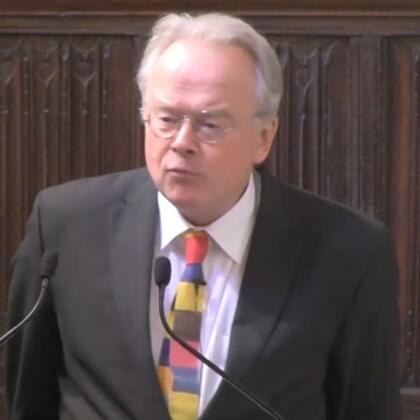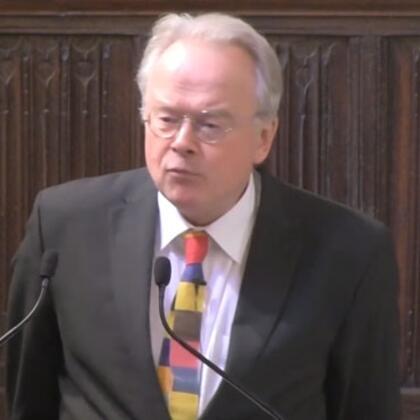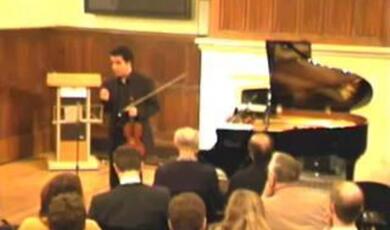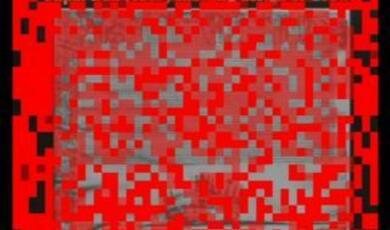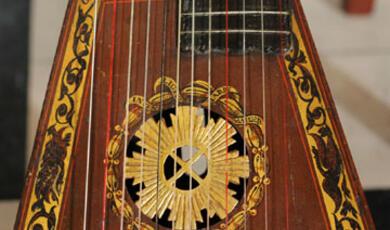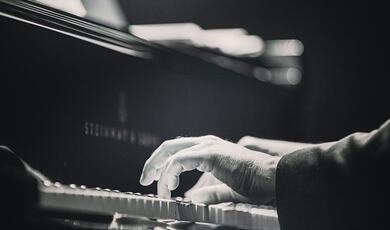Elgar and Musical Modernism: Elgar's Influence on Malcolm Arnold
Share
- Details
- Transcript
- Audio
- Downloads
- Extra Reading
The Institute of Musical Research, University of London and Gresham College joint event. This is the second part of the all-day event. It includes the following papers:
- Elgar's Influence on Malcolm Arnold (1921-2006): Elgar's Pomp and Circumstance as a model for a British Concert Overture? – Dr Raphael Thöne, University of Music and Drama, Hannover
- Elgar's Pianistic Iconoclasm – Professor David Owen Norris, University of Southampton and Emeritus Gresham Professor of Music
Convenors: Dr Paul Harper-Scott, Royal Holloway, University of London and Dr Daniel Grimley, University of Nottingham
The Institute of Musical Research, under the direction of Professor Katherine Ellis, is part of the University of London's School of Advanced Study, and was established to promote and foster the extraordinary richness of musical research in progress countrywide. It serves the university and conservatoire sector while building ties with other music-related organisations, and provides a base for visiting scholars from the UK and overseas.
Download Transcript
ELGAR'S INFLUENCE ON MALCOLM ARNOLD (1921-2006): Elgar's POMP AND CIRCUMSTANCES AS A MODEL FOR A BRITISH CONCERT OVERTURE?
Dr Raphael D Thöne
When contemplating terms such as 'tradition' and 'influence', almost immediately a quote from the British novelist William Somerset Maugham comes to my mind: 'Tradition is a guide and not a jailer'. At first glance this is a superficial statement, but still it attracts me, as it contains what I believe are two key aspects:
First, a creative artist, still being socialised by the inventions of the past, is never limited to the expressions and habits of previous centuries. In this respect, he is indeed, so-to- speak, free to coin his own cultural and creative identity, declaring this his 'new invention'.
He can either use tradition as an inspiration or, as in the case of many of the Avant-garde members of the 20th century, he can reject it on purpose, hoping that by doing so he has 'deleted' all remnants of the past and freed himself from the punishing and reactionary elements of his predecessors.
In this latter case - and I hope you will agree that to a certain extent all creative artists face such a quandary - if he has been a part of society and cultural life, he can indeed state that he has been free of influence. But he cannot declare that he has not noticed other voices of creative expression, nor that one or two minor, let's say, 'patterns', ideas or expressions that we would label part of 'tradition' did not inspire him, either directly or indirectly.
To be influenced or not: this might not be the question the artist himself would pose, but as analysts and researchers I think we simply cannot forget how powerful the influence of the past is in general and what limitations a belief in tradition can imply.
When I claim that the British composer Edward Elgar created a certain element of tradition by composing his Pomp and Circumstance Marches, which other composers - in my case, another British composer Malcolm Arnold - might have used as a model, I need to explain three things: what I mean by the term 'compositional model'; why I have chosen a particular concert march or overture to refer to; and, of course, how I am using the term 'tradition'.
Models are often described as giving evidence of the smallest essentials of an idea. In the case of music historiography or musicology, the preference for and application of models in music analysis has long been a nightmare. For composers, however, the term 'model' often goes hand-in-hand with 'influence'. Composers have been educated for centuries in composing based on stylistic models. In today's music composition and theory education, this has survived in writing classes as the mandatory pastiche.
The concert overture and concert march genre has been a relatively stable musical form in the previous centuries, and although its design has varied - the French Baroque overtures obviously cannot be compared to the Brahms Academic Festival Overture - British composers in particular have a long record of preferring this compositional form.
The original meaning of 'overture' or 'march' as a piece designed for a functional purpose within a ceremony or a dramatic work was even extended, particularly in the 19th century: the word 'concert' became the functional purpose and thus the keyword, and through this new 'environment' the concert room opened new possibilities for composers. The more a piece by a particular composer became successful there, the more it became an expression of its time - and contemporaries picked up on it, either simply for monetary reasons or because they believed it could give them an appropriate frame for their own compositional identity. A repetitive pattern was born: the model.
The Pomp and Circumstance Marches do not surprise with an ambiguous and ambivalent form. The musical language is not as advanced as in theEnigma Variations or The Dream of Gerontius, nor are the forms that Elgar chooses unusual or unexpected for his time: usually symmetric ABA forms, with some sort-of extra-codas or a rondo form such as in March no. 2.
Elgar insists on his subjects, either by re-stating middle trio subjects at the end of his marches, re-capitulating and performing them with the greatest nobility, or by literal repetition within the current form section. Development is not the keyword, but an adherence to musical mono-subjectivism seems to be his credo. This habit is most obvious in his second march, a sort of rondo-march with its three distinct but nonetheless not far developed subjects. It would be outrageous to expect a kind of development section within this rondo-march, but if we project a rondo form onto it, we can identify three subjects, as follows:
• a first subject, expected to be in A-minor, though elegantly switching back and forth around an a-centrality
• a B-subject, first appearing four bars after letter C, greatly pre-announced by a strongly accented and dominant French horn call
• a C-subject at letter G, recreating a kind of Brahms pastiche counter-subject in the gestus of the third movement of Brahms's Second
These three subjects all appear equally weighted and - I would stress - they present a sequence of single, humorous, self-contained but nevertheless limited ideas.
This may be the first hint towards Malcolm Arnold, though it is not obvious in his great symphonic works, such as Symphonies no. 2 and 6. Whether his subjects are taken from the concert stage or the world of film, Arnold also likes to cut short the emphasis on development. Instead of 'leading through' his ideas, as the German term Durchführung suggests, he sometimes lets his mind wander free.
Comparing Malcolm Arnold and Edward Elgar may appear to be a difficult task, other than the fact that both were knighted and both have been largely identified with one particular piece: in Elgar's case the Proms'Pomp and Circumstance; in Arnold's case the River Kwai March.
At first glance, the similarities end there. Perhaps one can argue that both were composers of popular and functional music and that neither balanced their compositional techniques on the question of whether they intended to compose - in our terminology - a serious or non-serious, let's say, 'functional' piece. I do not want to ignore the idea of real musical development in Elgar's style, but I agree with Charles Edward McGuire's observation that 'in no essential way does Elgar's popular and functional music for Empire and the First World War differ from the rest of his output' (McGuire 2004, p. 214). This is true whether or not we value any functional work from a serious perspective.
The questions, therefore, are: How can we identify Elgar's marches as a model for Malcolm Arnold if their appearance seems to be so unspecific? What gives us the right to suggest a connection between Elgar's marches and comparable marches or overtures written by Malcolm Arnold? And finally, how is it possible to describe such a phenomenon if Arnold presented a more direct tribute to composers such as Mahler, Sibelius and Berlioz - something we could not think of in the case of Edward Elgar?
Before comparing both composers musically and by their concept of our so-called 'concertante' functional music, I would like to return to the term 'tradition'. The German musicologist Hans-Heinz Eggebrecht, a long-standing antipode to Carl Dahlhaus, has suggested that we should separate 'tradition' into two distinct groups. In 1973, he broke down the concept of tradition into 'prevailing tradition' and 'understood tradition' (Eggebrecht 1973, p. 54). While 'prevailing tradition' refers to the subconscious influence of tradition and refers to the unconscious characteristics of one's own behaviour and actions, 'understood tradition' explicitly discovers and, as a consequence, is itself also uncovered.
I believe that in certain cases, rather than taking a strict music-theoretical approach, it can be helpful to reveal the unconscious even if it means that for a moment we must leave the field of comparative analysis and view a phenomenon from an unusual perspective.
In order to underpin my initial claims, I would like you to listen to a short excerpt I am going to perform for you, taken from the fourth Pomp and Circumstance March. Please note that since time is of concern, I have decided to exclude any redundant parts.
Performing example (Collage of Elgar march and Arnold march)
I hope you noticed the difference. Obviously, I have 'mis-performed' Elgar's Pomp and Circumstance March no. 4, but I may have also performed this piece in this manner on purpose. You have probably (and hopefully) never heard this particular march subject; it was first sketched by Malcolm Arnold as the 'The King March' in 1975 as part of a ballet project called The Three Musketeers for a Covent Garden production. The production was rejected at that time, and the piece itself has not been used in the current Northern Ballet Production. The current production is, to be honest, more a composite score of famous Arnold tunes than a real reconstruction of his dream. Also, be aware that my cited subject is only one of two subjects that Arnold sketches in 'The King March.' I will return to this later.
I have kept the harmonisation of Arnold's tune as close as possible; a few details were slightly re-harmonised to incorporate Arnold's tune into the context of this terrific rhythmically accented Elgar march. Instead of re-stating Elgar's original subject at letter C, you were suddenly confronted with a very short excerpt from the Arnold march.
What strikes me most is the fact that it would obviously be a different march, but the thematic 'break' you noticed while I was playing would have presumably, not occurred if Elgar's original statement had never been invented - or, more to the point, if Elgar had instead invented Arnold's tune. Even though this simple procedure of re-writing Elgar might be precarious, it is obvious that the musical language of both subject drafts is very close. Moreover, the question is: Which aspects did both composers share as common ground, both musically and aesthetically?
This is, on the one hand, created by the steady crotchet movement Elgar chooses for the bass movement of his nobility themes. This is underscored by the original march subject in March no. 4, as well as the better-known first march. Arnold has followed a similar approach in his sketch, first using minims as a steady bass line movement for the first part of his march subject and then later switching to a crotchet movement in the bass. While performing my collage, I did, however, prefer the crotchet movement, as it is the original context Elgar chose.
By the way, in passing I mentioned a significant word: 'nobility.' Matthew Riley has dedicated a long chapter to this aspect and also repeated Anthony Payne's emphasis on Elgar's eminent use of 4-3 appogiaturas or 6 or 6/5 harmonies (Riley 2007, p. 69f). But as Payne focuses on an intervallic description, Riley underpins Elgar's noble idiom by explaining the overall context with reference to Elgar's The Music Makers.
If we turn back to the original march subject that Elgar uses in his fourthPomp and Circumstance march, you will notice that suspensions and 6/5 chords are not over-applied. Instead, the impression of nobility is created by the very simple but effective prolongation of the notes 'e' in the third, and respectively 'g' in the seventh bar after letter G. Although the subject is, on its formal surface, only a typical antecedent-consequent structure, its impact is remarkable. The rhythmic and metric energy is first accumulated, and then suddenly, from the ninth bar on, the chord change frequency is accelerated and adjusted to the crotchet bass movement. Elgar employs a similar approach in the first Pomp and Circumstance March subject. Here, the prolongation is coupled with the 6/5 suspension in the melodic line.
Arnold's first march subject follows a similar principle: If we leave aside the dotted quaver notes and simplify the subject to its two-voice construction, we notice that Arnold heads exactly the same characteristic dissonant chord notes here: the 6/5 suspension. The metric catharsis Elgar achieves by prolonging the note 'g' in the earlier example is thus replaced. Arnold instead stresses the suspension-resolution process by literal repetition, which can be easily seen in bar two of his subject.
To be clear, Arnold and Elgar are two very different compositional personalities. The place where they differ - even when comparing marches that express high nobility - becomes obvious when we look at the further development Arnold undertook, which is demonstrated in his sketch. The second march subject, which appears right after the repetition sign, consists of four two-bar cells. The subject seems to be closely related to his initial first subject. In terms of chord change frequency, it might even be comparable to Elgar's march subjects in general. But it is clearly Arnoldian to literarily repeat and transpose a two-bar cell first to the E-major region, then to Eb and to a kind of Db-sphere, the latter pre-dating the resolution to the dominant C-chord. It is such a simple solution for a compositional problem, but instead of developing a high, sophisticated harmonic sequential pattern, as Elgar, for instance, does at letter C in his first Pomp and Circumstance march, Arnold prefers simple transposition. And we cannot suspect that he might have changed this in the process of orchestrating his sketch into a full-length march.
In conclusion, I would like to return to my initial points. 'Tradition' and 'influence' are two phenomena that usually rely on each other. Elgar might not have been the first composer to write marches expressing nobility, and he is also not the only British composer to be considered by audiences as 'imperialist' or particularly 'English'. But by composing, in particular, his first Pomp and Circumstance march,he delivered a piece that became a standard in itself. If a standard is a fortiori institutionalised, indirect influence can easily occur. It might be too general to suggest that Arnold is a composer who received much of his inspiration from earlier composers. As a composer, he developed his own distinct and remarkable voice and produced strong and unique works, such as his 7th symphony and his ballet Homage to the Queen, which display his gift for melodic sense, his use of polytonality and his sense of humour.
But much of his, let's say, functional music from concerts and film can be reduced to clear influential lines. By providing one of Elgar's lines here, I did not intend to reduce either composer's value; in fact, I intended the opposite. I wanted to emphasise that without tradition, past and influence, all creative beings are nothing. The British historian Eric Hobsbawn found the right way to put it: 'All human beings are conscious of the past... The past is therefore a permanent dimension of the human consciousness, an inevitable component of the institutions, values and other patterns of human society...' (Hobsbawn 1999, p. 13).
I hope that through ongoing research of 19th- and 20th-century British music, we will be able to find many conscious or, as in the case of Elgar and Arnold, unconscious lines.
Thank you very much for your attention.
Works Cited
Eggebrecht, Hans-Heinz (1999): Musikalisches Denken. Aufsätze zur Theorie und Ästhetik in der Musik. Wilhelmshaven: Florian Noetzel.
Hobsbawm, Eric (1999): The Sense of the Past. In: Hobsbawm, Eric (Hg.): On history. Reprint. London: Abacus (An Abacus book), p. 13-31.
McGuire,Charles Edward (2005): Functional Music: imperialism, the Great War, and Elgar as popular composer. In: Grimley, Daniel; Rushton, Julian (eds.) (2005): The Cambridge Companion to Elgar. Cambridge: Cambridge Univ. Press., p. 214-224.
Riley, Matthew John (2007): Edward Elgar and the nostalgic imagination.Cambridge: Cambridge Univ. Press.
©Dr Raphael D. Thöne, Gresham College, 14 December 2007
____________________________________________________________________________________
ELGAR'S PIANISTIC ICONOCLASM
Professor David Owen Norris
In childhood, Elgar used the piano to play continuo (from a Vivaldi figured bass) and to improvise. Rosa Burley tells us he played 'a sort of continuo' with school ensembles in 1891. His improvisations in later life were famous for their orchestral effect. We can hear something of this in the Third of the improvisations he recorded straight onto hot wax in November 1929.
MUSIC 1 from CD Elgar, Improv 3, a minute or so.
Those fingers sound as if the piano's quite familiar to them! But what they're playing is difficult to notate. There's a danger that writing it down will tame it, and it'll end up sounding like this.
MUSIC 2 Improv 3, stilted
The habit of inventing orchestral keyboard effects that can't be notated, and a familiarity with the freedoms of continuo playing, may well enlarge horizons beyond a normal, schooled, manner of writing for the piano.
Elgar's very original approach to the instrument is most clearly demonstrated in his frequent staccato bass lines. Many pianists carelesslybind these with the sustaining pedal. Yet Elgar makes his wishes clear. InA Soldier's Song of 1884 (or at any rate in its 1903 reprinting as A War Song), the first two bars invite pedal. But both bars have copious rests and dagger staccato marks, and Pedal is actually marked in the third bar. The dot staccato marks in this third pedalled bar may be considered indications of touch within a pedal.
MUSIC 3 War Song 1sr 3 bars
The last bar of the page shows an insistence on staccato, with dots, rests, and the word stacc.
MUSIC 4 last bar of page
The danger of attributing a system to any composer's use of the pedal, however, is shown in the second line of the second page, where an unequivocally long pedal incorporates dagger staccatos, which cannot therefore automatically mean 'no pedal'.
MUSIC 5 p2 s2
It's worth pointing to a difference between the first and second choruses, each identically accompanied by repeated triplet quaver chords. The first chorus marks the first crotchet's-worth with staccato dots in left and right hand, and puts a pedal mark a couple of bars later. The assumption is that the beginning of the chorus is unpedalled.
MUSIC 6 1st chorus
The second chorus, mf rather than p, has neither staccato marks nor subsequent pedal marks, allowing the assumption that the pedal should be used:
MUSIC 7 2nd chorus
an example of the care Elgar took to vary repeated phrases. This also explains the addition of pedal to a dominant re-statement of the opening bars, originally unpedalled. [The most striking example of this variation is in the composer's bowings in the Introduction & Allegro, where repeated phrases like those in the viola's 'Welsh' tune are bowed in such a way that the repeat is 'upside-down'. All the library parts of the piece that I've looked at have 'corrected' Elgar's bowing in pencil.]
The lengthy ballad As I laye a-thynkynge, composed in 1887, again establishes a staccato accompanimental figure before adding pedal to emphasize a harmony ('There seemed a crimson plain', etc.)
MUSIC 8 there seemed a crimson plain
At the foot of the same page the piano has a bass-less staccato texture which may have its origin in an imagination soaked in clarinets and flutes, but which the piano can make its own with great effect.
MUSIC 9 high texture
As well as unusually spare, unpedalled textures, the ballad has very long spans in one pedal, which can blur on a modern piano (though we should always remember that with careful pedalling with leather-soled shoes, the dampers can be barely lifted from the strings, ameliorating the blur.) However, on a piano of the period, Elgar's long pedal marks, like those of Brahms, work perfectly without a great deal of foot-finesse.
It may be that some of the subtleties I detect in Elgar's pedalling marks are figments of the printer's inaccuracy. The pedal mark at the end of the second song of Sea Pictures, for instance, is simply wrong.
MUSIC 10 In Haven end
Elgar's manuscript sketch shows that the pedal he had in mind was, for once, what one might expect.
MUSIC 11 In Haven end
I hope to find the opportunity to see many more such pedal marks in Elgar's own hand. But for the moment, let's assume an honest printer, and move on to some subtle pedal markings in the song After of 1895.
The opening puts down a bass note, and then adds a two-handed chord. The chord has a pause over it in both hands, but the continuing bass note, tied below, has no pause. Pedal is marked from the beginning, and the off-asterisk is quite close after the tied bass note. I assume that this means:
MUSIC 12 & slide After, opening
The similar passage at the end has three pauses, one for each hand of the chord, and one for the tied bass note. I imagine that means:
MUSIC 13 & slide After, ending
The identical effect occurs in Queen Mary's Song of 1887.
MUSIC 14 QM, end 1st v
That's the end of the first verse. The end of the second is more complex, as the notation shows. Clearly, it means this:
MUSIC 15 & slide QM end
I believe the same thing happens at the end of Dry those fair, those crystal eyes, written in 1899. The last bar has a tied minim D with a pause on it at the top; underneath, a spread crotchet chord followed by a crotchet rest with a pause on it. The pedal mark, however, extends to the very end of the bar. The fact that the pedal mark is there at all shows that Elgar did not want a clinical reading of it:
MUSIC 16 Dry, end
But if the pedal mark comes at the end of the bar, why not write a minim chord?
MUSIC 17 same
I take this bar as evidence that Elgar's ears were closely enough attuned to the piano to imagine a slow release of the pedal, leaving the D unsupported.
MUSIC 18 same
It might be argued that he would have put a pause on the spread chord, but that would have implied yet a further version.
Let me return for a moment to Queen Mary's Song to point out the very characteristic arpeggios. These are not just to suggest the lute mentioned by the singer. They form a particular texture which works well in support of the melody; even more so on a period piano.
MUSIC 19 QM tune
That this was a conscious choice of a texture is shown by Elgar's exquisite piano solo arrangement of Salut d'amour, which arpeggiates chords that in the piano accompaniment were played straight - or as straight as anyone played anything in those days.
MUSIC 20 (two bits) Salut acc and solo
An arpeggio in the piano version of the last song of Sea Pictures makes a splendid rhetorical point. (bar 100)
MUSIC 21 bar 100
I may say at this point that I regard Sea Pictures primarily as a work with accompaniment for piano rather than orchestra. Amanda Pitt and I have given some twenty performances of it this year, and many listeners have come up to tell me how good it sounds on the piano. It contains subtle pedal effects. The blur in the first song:
MUSIC 22 1st song opening
is not reproduced in Elgar's orchestration.
MUSIC 23 same
Yet that blur brings so much to the song. In Where corals lie, the chords are marked staccato and with pedal, a marvellous effect with a delicate foot, reminiscent of Chopin's F minor Nocturne, whose chords also have staccato dots and pedal, though the exact placing of Chopin's asterisks is unclear. (Elgar gets round that by simply writing con ped and trusting his pianist.)
MUSIC 24 Chopin
The apparently orchestral tremolandi can be made pianistically effective with only a little thought.
MUSIC 25 Recit
A comparison with Schoenberg's Op.1, two piano songs written at about the same time as Sea Pictures, reveals Elgar's subtlety in the matter of tremolando.
MUSIC 26 Schoenberg
The general disdain for piano tremolando shown by the more precious critics had an unfortunate outcome in the re-publication by Novello, 31 years ago, of Elgar's 1905 piano piece In Smyrna. [It appears with the piece Skizze in a slim pamphlet oddly entitled: Sir Edward Elgar: Two Piano Pieces: for Piano.] The opening presents an awkward mix of oscillating semiquavers in 4s and a melody with triplets. The semiquavers are written out in full.
MUSIC 27 S, opening tune
In the original publication, a Christmas Annual, the oscillation is printed astremolando minims. The prescient Elgar, in an attempt to insure against some later editor ignorant of what the notation meant, actually added the word trem. But in vain. I gave the first performances of the correct version this summer, but I'm afraid my recording is wrong. Once you've heard this, there can be no doubt that tremolando is a legitimate piano effect.
MUSIC 28 same
The melody, like all Elgar's piano melodies from the Sonatina onwards, is perfectly designed for the resonance and decay of the instrument. Here's the tune from the Concert Allegro, for instance.
MUSIC 29 Tune, CA
I looked at the original print of In Smyrna in the hope that it might clarify some of the pedal marks, but Novellos did manage to copy themaccurately from the original print. The manuscript is at Northwestern University, so that will be a little task the next time I'm in Chicago.
But though Novellos got the marks right, I fear I interpreted one of them wrongly in my recording. A semibreve dyad D/A is underpinned by a crotchet rest and three staccato crotchet Ds in the bass. Under the last crotchet is a pedal mark. The next bar begins with a D major chord. The pedal-off asterisk comes halfway through this. When I recorded the piece, I treated the third staccato dot as an indication of touch-within-the-pedal, and played this:
MUSIC 30 S, bottom of page
But now I think Elgar meant me to release the bass D before pedalling, so that only the dyad rings on under the chord, thus:
MUSIC 31 same
I should have realized, because the similar effect at the end I did get right on the recording. The low G in the bass is tied on to a minim and a semibreve. The minor third above it is a crotchet with a staccato dot. The word Ped is printed below the low G. The staccato dot implies that one should clear the crotchet before putting the pedal down. This means that the final chord has no minor third in the tenor register - a subtle but important point. So it sounds, not like this:
MUSIC 32 S end wrong
But like this
MUSIC 33 same, right
Elgar's piano writing has the strange property of exciting intemperate criticism. Sir Clifford Curzon spoke of 'the rhetoric of the piano tuner' so often that I've heard it from several different sources, some of whom should know better than Curzon. A recent lecture-recital at the Barber Institute was subtitled 'Why our greatest Romantic composer could not quite write for the keyboard.'
Dunhill writes of the 'earnest ineffectiveness' of the piano writing at the beginning of the Quintet. Can't hear it myself.
MUSIC 34 PQ opening
Fascinating pedal mark on the long D, presumably so that the piano can resonate in sympathy with the quartet's chromatics. The mark's cancelled in time for the staccato bass.
After Figure 2 comes a good example of a staccato bass with slurred right-hand chords. Finger legato is required, and one is reminded that Elgar, like that great piano composer Mendelssohn (and many others) was an organist. Another apparently otiose pedal mark on a single chord on the same page again gives resonance to the quartet.
Before figure 6, the quartet returns the compliment, and sustains chords that the piano should lift, if the pianist notices the pedal asterisk and staccato marks. A few bars later is another staccato bass with sustained right-hand.
Before Fig 32 in the slow movement, the piano harmony is staccato, while the strings again sustain. Tempting during solitary practice to deploy the pedal.
MUSIC 35 Fig 32
The second subject of the Finale is an idea almost entirely of articulation that cuts across all the habits of a pianist's foot. (Fig 49)
MUSIC 36 & slide Fig 49, slowly
Let me give a few examples of textural ingenuity from the Violin Sonata.
First, a passage just before fig 2, where the piano first announces a figure legato, with staccato, yet phrased, bass:
MUSIC 37 Fig 2
When the violin repeats the phrase, the piano plays it staccato.
MUSIC 38 on
At fig 29 in the middle movement, the pedal mark turns what pianists would play:
MUSIC 39 (two bits) fig 29
into a richer idea
MUSIC 40 same
Just before the coda in the Finale, the bass is for once allowed to be non-staccato, but against carefully differentiated, shorter, right-hand chords.
MUSIC 41 before Coda
Returning to the Quintet, some of its odder pedal marks stem from Harold Brooke, Novello's reader, and the man whose more than competent arrangement of the Coronation March, complete with unorthodox fingering, may have impressed Elgar enough for him actually to leave some of the details of the Quintet's piano writing to Brooke, inviting him to re-write what he called the 'tadpole passage'
MUSIC 42 tadpole
and the 'straddle-bug passages'
MUSIC 43 straddlebug, staccato
where Brooke's contribution was merely to put a legato slur where Elgar had had staccato. I prefer Elgar's strenuous idea.
Here we have the obverse of the problem we heard in Elgar's improvisation at the beginning. Since he asked for Brooke's help, Elgar must have invented something he could not notate. But we only have his notated version. What might he have played? In recent performances of the Quintet and the Sonata I have allowed myself some freedom with the piano parts, going beyond them in the style familiar to me from the recorded Improvisations. Audiences have been pleased with the results of this approach. This is why Elgar declined Compton Mackenzie's request to record the Quintet, of course, saying 'I scramble through things orchestrally in a way that would madden with envy all existing pianists' - a splendid and justified boast immediately defused by the sad remark 'I never did play really'. There's no time today to explore how it was that Elgar became so conflicted about his pianistic powers, so I'll refer you to the liner notes of my CD of the Complete Piano Music on Elgar Editions. It's all to do with Fanny Davies and the Concert Allegro, and the fact that Davies and Elgar did not meet until a quarter of a century after she had sunk the piece without trace.
But there is time to give a few examples of Elgar's pianistic iconoclasm from the Concert Allegro. Curzon was probably put off by the glissando on the very first page.
MUSIC 44 opening CA
Fanny was doubtless appalled by the passage that seductively invites the thumb onto a black note.
MUSIC 45 semis
She accepted it the first few times, but by half way through, she was suggesting alterations, some of which hopelessly traduce the harmony.
MUSIC 46 & slide MS top
That page also shows my favourite example of the non-meeting of minds, where Elgar inserts a sheet of paper solely to add a nine-fold rhetorical repetition of two semitones.
MUSIC 47 MS bottom
Above it, Fanny has written querulously '?once?', a remark so splendidly fatuous that the British Library has not attempted to erase it. Unfortunately, Elgar bowed to her opinion, though not to the extent of publishing it. I should mention that the Novello print is inaccurate even by its own lights.
But back to fingering. The opening of the finale of the Quintet, like the Concert Allegro, shows Elgar's unusual approach to fingering. This figure was conceived by someone who put his thumb under his fifth finger.
MUSIC 48 Opening finale PQ
This year I've been playing an unrecognized Brinkwells piano piece, albeit an arrangement, that shows great ingenuity in arpeggiation. It's the piano version he made for The Windflower of what became the theme of the Cello Concerto. The right hand has to play theme and chords, which are disposed in such a way as to require a downward spread.
MUSIC 49 ?
Perhaps it was William Walton who invented the special sign for this in his Sitwell songs - I don't call to mind an earlier example; but it's good to see old Sir Edward blazing a trail for his youngers. [I'm not suggesting, of course, that Walton knew this piano piece.]
Elgar was perfectly capable of writing superbly in the conventional piano style. This is shown by the unfortunately-titled song The Wind at Dawn, of 1888.
MUSIC 50 Wind
Really 'pianistic', in the conventional sense. What has been regarded as Elgar's clumsier piano writing, therefore, must be serving some other composing purpose.
And so at last I come to tie pianistic iconoclasm to the subject of this conference. Where do we find piano writing with staccato basses and legato trebles? With tremolandos, and peculiar pedal effects? With the idiosyncratic fingering that the composer himself preferred? Well, we find all that in this Piano Sonata, or this Violin Suite. And as to piano glissandi, what about Petrushka? But when Stravinsky does it, it's modern.
©Professor David Owen Norris, Gresham College, 14 December 2007
Part of:
This event was on Fri, 14 Dec 2007
Support Gresham
Gresham College has offered an outstanding education to the public free of charge for over 400 years. Today, Gresham plays an important role in fostering a love of learning and a greater understanding of ourselves and the world around us. Your donation will help to widen our reach and to broaden our audience, allowing more people to benefit from a high-quality education from some of the brightest minds.


 Login
Login

